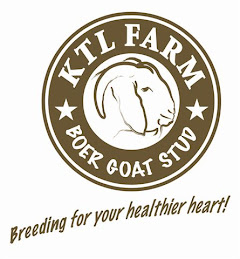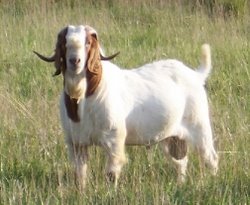(Information from http://studbook.co.za/Society/B.Goat/value.php)
Economical farming implies profitable farming, in other words the more profit you make out of your farming enterprise, the more economical or profitable it is. The livelihood of the farmer thus depends on his farming with that animal or crop which will ensure that he receives the highest possible yield and profit in the climatic and soil conditions applicable to his circumstances. He also depends on optimal utilisation of each natural source, in such a way that the resource in question will not deteriorate as result, but will rather be improved over the long term. The Boer goat fulfils the above aims in the following ways in terms of its characteristic features:
MEAT AND PELTS OF A HIGH QUALITY
Considered in the light of the health-consciousness that prevails on a worldwide basis, the Boar goat yields lean meat of a high quality, particularly during the young stage. The meat is flavoursome, succulent, tender, extremely attractive and very tasty. Currently, the meat is much sought after for barbecue and spit roasting purposes. For this reason, goats should be marketed between the ages of 6 and 15 months, and carcasses should weigh no more than 23 kg. Older goats in good condition yield biltong (dried meat) and dried sausage of very good quality, which can definitely compete with the very best on the market.
In the light of the predilection for the Boer goat meat displayed by certain consumers in South Africa and the rest of the world, along with the characteristics required for the right type of meat for the health-conscious sector of consumers worldwide, one cannot do otherwise than predict a rosy future for Boer goat meat originating from goats of a high quality.
The results achieved by Boer goats, expressed in percentages, are very good, fluctuating between 48% and 60%. These results are narrowly linked to the age and more particularly the quality of the animals.
| | Ewe 15 months. | |
THE PELT
The pelt of the Boer goat has a low leather value in comparison with that of other small stock breeds. An endeavour should be made to breed goats with short, smooth hair, since this increases the quality of the pelt. The pelts of Boer goats are used for making the uppers of shoes, as well as for gloves and the covers of books.
HARDY AND ADAPTABLE
During drought conditions, the Boer goat probably survives longer than most other animals without supplementary feeding or feed.
RESISTANCE TO DISEASES
The Boer goat also has an exceptional ability to withstand and resist diseases such as blue tongue, prussic acid poisoning and, to a lesser extent, enterotoxaemia (pulpy kidney). As far as is known, Boer goats do not contract blue tongue at all. Their grazing habits also make them less susceptible to infection caused by internal parasites, since Boer goats prefer to graze above the ground, if such grazing is available. Such as bushveld or scrub vegetation.
FERTILITY AND KIDDING PERCENTAGE
The Boer goat is very fertile and is not seasonally bound. Furthermore, multiple births are the rule rather than the exception, with an average kidding percentage of 180.
These two important economic characteristics have made the Boer goat very popular for the following reasons:
- Because the Boer goat is not seasonally bound, the kidding season can be selected to fit in with the period when food is most plentiful; or, under intensive conditions, kidding can occur every 7-8 months.
- Its exceptionally high kidding percentage implies that the Boer goat cannot be surpassed with regard to the percentage of meat per kilogram per ewe or per hectare. This factor places the Boer goat very high on the ranking list with regard to intensive farming.
ABUNDANCE OF MILK
Growth rate is linked to sufficient milk production and good nurturing instincts in ewes with regard to their young.
An ewe has enough milk to raise two kids rapidly.
LONGEVITY
The Boer goat is able to maintain economic production up to the age of approximately 10 years. This implies that the percentage of young replacement ewes which have to be withheld, is very low.
GRAZING HABITS
Goats prefer small trees and shrubs as their basic diet, but their exceptional economic value lies precisely in the fact that they are able to utilise certain plants which are less appetising to other stock breeds.
Experiments undertaken at Omatjenne Experimental Farm in Namibia have proved that a Boer goat consumes 74 % leaves and 26% grass. As a result, it is possible to farm with cattle and Boer goats simultaneously without their being in competition with each other to any great extent, so that a maximum number of kilograms of meat per hectare can be produced. As a result of the grazing habits of the Boer goat, it can be successfully incorporated in this way in order to utilise bushes and shrubs, and thus to assist in controlling encroachment.
When one considers all these characteristics of the Boer goat along with all the space available in South Africa, as well as abroad, where Boer goats could be successfully accommodated, it is natural to assume that this industry will but grow in the future.

